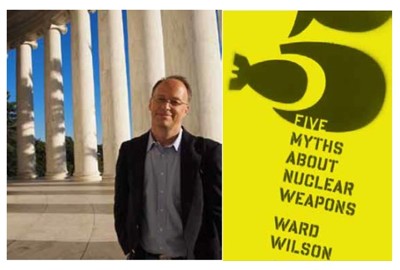By Jean-Marie Collin, “Blog Défense et Géopolitique, Alternatives-Internationales”
Here’s a book worth reading! Its author, Ward Wilson, deconstructs in simple terms the myths that “protect nuclear arsenals”. His book is a success, because after publication in January last year, he hasn’t stopped travelling the world and large international bodies to present his reflections. On the 20th of February he was invited by the United Nations Office of Disarmament Affairs to present his thesis.
Despite the reduction of nuclear arsenals over the last thirty years, it’s a fact that the nuclear powers are resisting the calls for general and complete nuclear disarmament. This type of weapon, manifestly dangerous, but “apparently necessary”, poses many serious security problems for the international community. Through this concise analysis of received ideas, the 5 myths of nuclear weapons, W. Wilson shows that since the bombing of the Japanese cities of Hiroshima and Nagasaki everything has been done to affirm the value and the political-military asset of these weapons.
The first myth (“Nuclear weapons shock and awe opponents”) affirms that nuclear weapons put an end to the Second World War. It is evident in this way of thinking that there’s no place for the morality of knowingly killing civilian populations! Numerous researchers have shown clearly that Japan capitulated not because of the atomic bomb, but because the Soviets renounced their neutrality by joining the war and invading Manchuria. To attribute victory to this sole “miraculous” weapon was a comfortable lie for the two future nuclear powers; but to attribute this defeat to this miraculous weapon was also a way for Japan to avoid any sense of shame.
The second myth (“H-bomb quantum leap”) regards the destructive power of the weapon as a decisive power. But massive destructive doesn’t allow wars to be won, but only kills soldiers and civilian populations. W. Wilson takes as an example the siege of the city of Stalingrad by the Nazis that discouraged the soviet forces from making a front not one bit! To build increasingly destructive weapons only increases the horror of war and brings absolutely no certainty of putting an end to them.
The third myth (“Nuclear deterrence works in a crisis”) rests on faith in the power of nuclear deterrence. The example generally used is the Cuban Missile Crisis where Soviet and America leaders stood their ground at the risk of setting off a nuclear war. This possibility of nuclear war was mentioned several dozen times during the course of the crisis itself by the leaders of these two countries. The fans of deterrence could sustain the fact that finally a nuclear conflict was not uncorked, thereby accrediting the theory of nuclear deterrence. But to think this way means nothing more than tackling the problem the wrong way and shutting your eyes to the real danger that the use of this type of weapon would provoke. In fact, originally it was affirmed that possession of nuclear arsenals would prevent all attacks against the countries that possessed them and against those who benefitted from the so-called “nuclear umbrella”. However, possession of this force guarantees nothing. The Yom Kippur War and the Falklands have shown well that a non-possessing state could attack a nuclear power. So this calls into question the idea of protection created by this “umbrella”. In fact, if a nuclear power cannot defend its own territory, even remote islands, how could the umbrella defend another country?
The fourth myth (“Nuclear weapons keep us safe”) consists of saying that the bomb assures peace, using as proof that there hasn’t been a nuclear war since 1945. But how does proof-by-absence verify this theory? How can we affirm that the presence of nuclear weapons alone has given rise to peace and the avoidance of war between the Americans and the Soviets? It simply rests on the absence of proof. In other words we have a hypothesis to guarantee peace which seems very difficult to endorse, while at the same time risking the lives of millions of human beings.
The last and fifth myth (“There is no alternative”) is about irreversibility. Realists say to the idealists (those who want disarmament) that no, in a “condescending tone. ‘You cannot put the genie back in the bottle’.” It’s true that it’s difficult to uninvent technology, in this case the bomb. Nevertheless, it can disappear either because a more modern technology has been found or because it becomes obsolete. Regarding nuclear weapons, the question is therefore not of knowing if they could be uninvented but rather knowing if they have any use? It is clear that no one has found a use for them since 1945; on the contrary weapons research today is in the area of precision and miniaturisation and not in weapons of mass destruction.
Through his work, Ward Wilson is therefore sending a strong signal to completely and concretely rethink nuclear weapons, with the aim of achieving global nuclear disarmament.






